Abstract
Context:
The macrofollicular variant of papillary thyroid carcinoma (MFVPTC) is a rare entity; this variant is a well-differentiated tumor with predominance of macrofollicles lined by cells showing the nuclear features of papillary thyroid carcinoma (PTC). It is claimed to be clinically nonaggressive with a low incidence of metastasis. It is very important to correctly recognize this entity, it might clinically represents a dangerous source of diagnostic error, since it can be easily misinterpreted as a benign disease such as goiter, macrofollicular adenoma, Grave's disease, or hyperplastic nodule. The objective of this article was to provide an update overview of the clinical, cytologic, histologic, and immunohistochemistry (IHC) as well as the molecular characteristics of MFVPTC.Evidence Acquisition:
This rare subtype of papillary thyroid carcinoma was first described in 1991. We performed a comprehensive online literature review since its first description up to this date.Results:
MFVPTC is a rare variant of papillary thyroid carcinoma that can be extremely difficult to diagnose preoperatively; however, IHC stains and molecular studies might help to differentiate this neoplasm from other thyroid entities.Conclusions:
This review highlights the diagnostic difficulties that both clinicians and pathologists face when dealing with follicular variants of papillary thyroid carcinoma. While IHC and gene mutation studies are helpful in narrowing down the differential diagnosis, these techniques need further improvements in order to increase their diagnostic accuracy.Keywords
Macrofollicular Variant Papillary Thyroid Carcinoma Papillary Thyroid Carcinoma Fine Needle Aspiration
1. Context
Papillary carcinoma of thyroid (PTC) is the most common malignant thyroid tumor, comprising approximately 80% of all thyroid cancers. PTC has a very broad morphologic spectrum with many histologic variants (Box 1), which their classification is important because patient's outcome in some variants differ from conventional PTC (1). The follicular variant of PTC (FVPTC) is defined by the presence of tumor cells arranged almost entirely in a follicular pattern with the nuclear features identical to that of PTC. The macrofollicular variant of PTC (MFVPTC) is an extremely rare entity, accounting for 0.3% of PTC in Japan (1). It was first described as a distinct entity by Albores-Saavdra et al. in 1991 (2). Histologically, according to the definition given by Albores-Saavdra, MFVPTCs are characterized by the predominance of macrofollicles (follicles >250 μm) (Figure 1), occupying more than 50% of a cross-sectional area (3, 4). In contrary, according to Gamboa-Dominguez et al. (5), the MFVPTC is composed of follicles with a mean diameter of at least 200 μm, surrounded by a thick fibrous capsule that resembles macrofollicular adenoma or nodular goiter.
The cells lining the macrofollicles have nuclear features of characteristic PTC including enlarged ground glass clear nuclei, with intranuclear pseudoinclusions and nuclear grooves (Figure 2).
Variants of Papillary Thyroid Carcinoma
| Variants |
|---|
| Conventional |
| Follicular variant |
| Papillary microcarcinoma |
| Tall cell |
| Oncocytic |
| Columnar cell |
| Diffuse sclerosing |
| Solid |
| Clear cell |
| Cribriform-morular |
| Macrofollicular |
| PTC with prominent hobnail features |
| PTC with fasciitis-like stroma |
| Combined papillary and medullary carcinoma |
| PTC with dedifferentiation to anaplastic carcinoma |
Low Power View Showing a Macrofollicular Patterned Lesion.
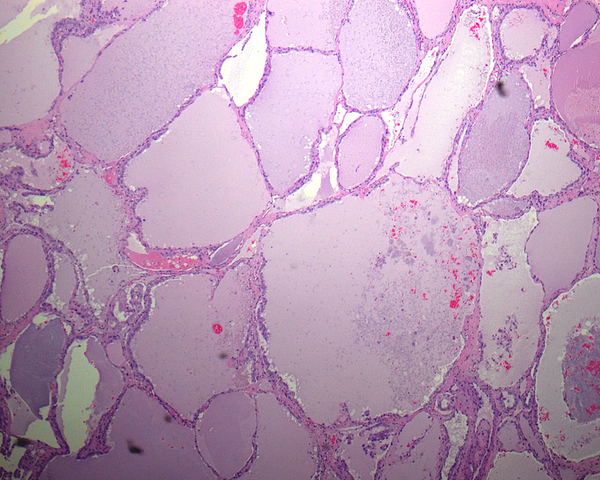
High Power View of Papillary Thyroid Carcinoma Showing Follicles Lined by Cells With Nuclear Enlargement and Remarkable Clearing
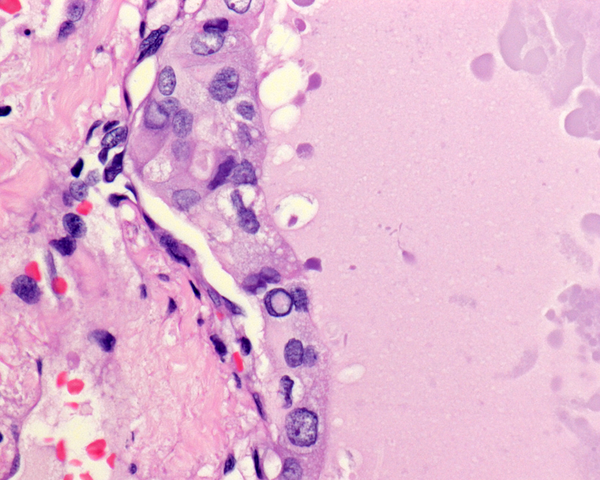
2. Evidence Acquisition
2.1. Clinical Features and Presentation
PTC represents the most common thyroid epithelial malignancy diagnosed in the regions where thyroid goiter is not endemic. Although they are rare before age of 15, they represent the most common pediatric thyroid malignancy. The most common etiologic factor is radiation, but genetic susceptibility and hormonal factors also contribute to the development of PTC. Generally, the median age at diagnosis is 44 years in FVPTC, which is similar to that of PTC (43 years) (5). The female to male ratio is 6:1. Both FVPTC and PTC are presented as thyroid masses. At the time of diagnosis, the rates of extensive extrathyroidal local spread, bilateral lesions, and vascular invasion were higher in FVPTC than in classical PTC (6, 7). It is well known that patient outcomes of some variants differ from conventional PTC (1).
As shown by previous studies from Western countries, MFVPTC is characterized clinically by nonaggressive biologic behavior with a low incidence of lymph node metastases and good prognosis (2, 4). Moreover, it has a macrofollicular pattern. Therefore, it might represents clinically a crucial source of diagnostic error since it can be easily misinterpreted as a benign disease such as goiter, macrofollicular adenoma, Grave’s disease, or hyperplastic adenomatoid nodule (6). In a report of five MFVPTC cases by Fukushima et al. (8), preoperative ultrasonographic examination showed that two patients had benign nodulesand the remaining were suspected of having PTC. None of the patients showed apparent lymph nodes metastases on ultrasonographyor massive extrathyroidal extension before operation although lymph node metastases were observed in three patients on postoperative pathologic examination. It is possible that some macrofollicular variant cases have been followed-up based on a misdiagnosis of benign thyroidnodules.
The prognosis of MFPTC is reported to be excellent with a low incidence of metastasis as compared to conventional PTC or columnar cell variant (9, 10). The various factors which are considered to be of prognostic importance in a patient with well differentiated PTC are young age, small tumor size, absence of extra thyroid extension or blood vessel invasion (11). Recent studies by Liu et al. (12) have showed that encapsulated lesions without invasion have an excellent prognosis. These encapsulated lesions have a clinical behavior very similar to follicular neoplasms of the thyroid (12).
2.2. Morphologic and Immunohistochemical Features
FVPTC in general and MFVPTC in particularpose common and challenging diagnostic difficulties. The difficulties are encountered in both cytologic preparations and histologic sections and are usually due to a high number of these tumors develop within a background of nodular goiter or macrofollicular adenoma.
Fine needle aspiration (FNA) is an efficient tool in evaluation of many superficial organs such as lymph nodes (13) as well as deep organs such as the pancreas (14). In contrast to FNA findings of the classical PTC, where this investigation has been shown to have high sensitivity and specificity allowing endocrine surgeons to proceed with total thyroidectomy (15-19), FNA of FVPTC, especially the MFVPTC, is not much helpful in reaching this diagnosis. The macrofollicles contains abundant colloid and some are lined by follicular type of epithelium; hence, the cytologic features are quiet often similar to adenomatous goiter and to macrofollicular adenoma (20-24). For discriminating MFVPTC from these entities on FNA cytology, we depend on the nuclear features characteristic for PTC, which are typically seen in MFPTC (25).The cellular features of MFVPTC are identical to that of PTC and include clear nuclei, nuclear grooves, and intranuclear pseudoinclusions (26) (Figures 3 and 4). MFVPTC tends to have fewer calcifications and less psammoma body formation in comparison to conventional PTC. In all FVPTCs, including the macrofollicular variant, a significant inter-observer and intra-observer variations have been noted even among experts, with major inter-observer disagreements reported in up to 40% of cases (27). A general consensus exists as to the most important diagnostic features, which include nuclear clearing, nuclear grooves, nuclear overlapping and crowding, nuclear membrane irregularity, and nuclear enlargement. Discrepancies arise due to the lack of agreement on the minimal necessary criteria for a definite diagnosis of MFVPTC. Factors that most likely contributed to a false negative diagnosis in some cases included low cellularity, predominance of macrofollicular pattern, presence of macrophages, paucity or absence of nuclear pseudoinclusions and/or nuclear grooves, and presence of moderate to abundant thin watery colloid. Sampling was probably one of the causes for the false negative diagnosis since the nuclear changes suggestive of papillary carcinoma, while undoubtedly present in the histologic sections, were often focal in nature. Unfortunately, the presence of few grooves is not particularly helpful in making the correct diagnosis as it can be focally seen in a variety of lesions including goiter and Hurthle cell lesions. Nuclear overlap, small peripheral nucleoli in atypical follicular cells with grooves, and presence of focal abnormal dense colloid in a background of watery and thin colloid were the most common features in the FNA of MFPTC (26, 28).
Papillary Thyroid Carcinoma, Fine Needle Aspiration Cytology Showing Nuclear Grooving
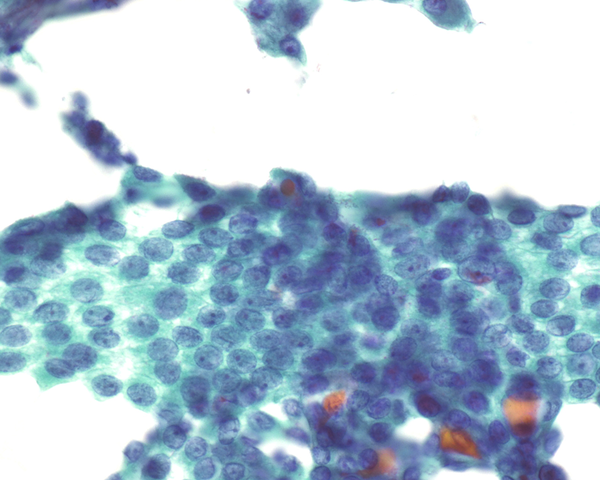
Papillary Thyroid Carcinoma, Fine Needle Aspiration Cytology Showing Intranuclear Pseudoinclusions
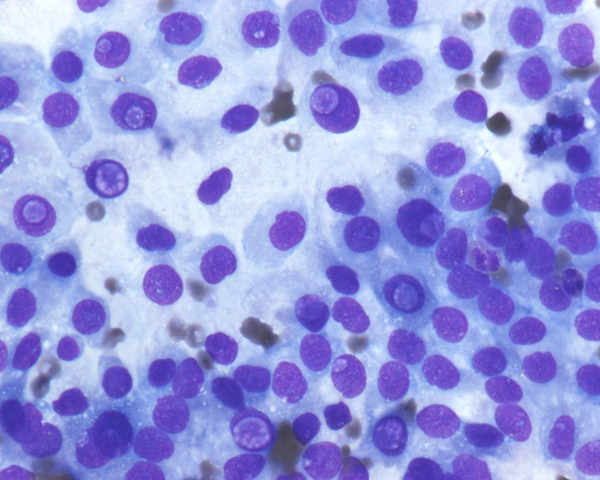
The absence of strict and uniform criteria among expert pathologists, particularly in difficult cases, results in the use of terms such as “multifocal PTC arising in a benign nodule” and “follicular tumor of uncertain malignant potential”. Therefore, there is controversy regarding reporting the cytohistologic condition of these lesions (27, 29-31) and a range of proposals have been made to clarify this issue. LiVolsi and Baloch preferred a scheme in which a diagnosis of MFVPTC would be made on any encapsulated lesion showing any area with the characteristic cytologic features of PTC (32). Chan suggested using stricter criteria including the evaluation of major and minor features. Some immunohistochemical markers, such as high-molecular-weight cytokeratin, cytokeratin 19, vimentin, HBME1 (Figure 5), CD57, CD15, and CD44 have been reported to be more commonly expressed in PTCs than in benign thyroid lesions. These markers are not sufficiently discriminatory to aid in the diagnosis of problematic encapsulated follicular lesions of the thyroid (31).
Macrofollicular Variant Papillary Thyroid Carcinoma, Positive Immunohistochemical Stain for HBME1
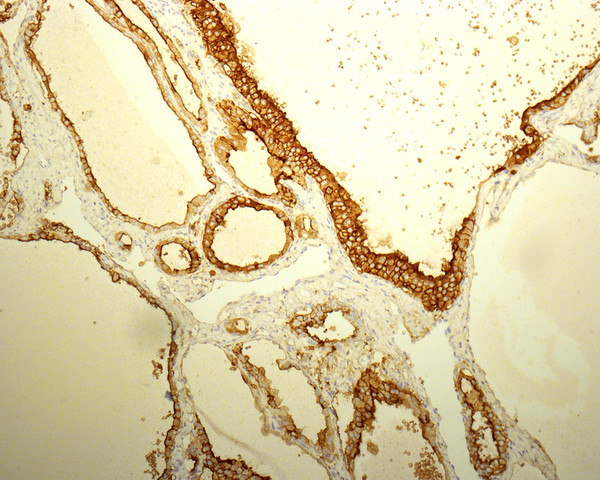
3. Results
3.1. Molecular Genetics of FVPTC/MFVPTC and Its Diagnostic Clinical Utility
Several oncogenes are involved in tumor genesis of thyroid carcinoma (33, 34). MFVPTC has molecular characteristics between the two well-differentiated thyroid carcinomas, i.e. follicular carcinoma (FC) and PTC. FC is characterized by RAS mutations and PAX8/PPARγ rearrangement (34-37). The gene fusion of PAX8/PPARγ rearrangement has been cytogenetically defined as translocation t(2:3) (q13; p25) (36). PTC has a genetic profile consisting of somatic rearrangements of the RET proto-oncogene (34, 38) and BRAF mutations (39, 40). MFVPTC has a high occurrence of RAS mutations and PAX8/PPARγ rearrangements (41) but a less common BRAF K601E form, which is present in about 7% of cases (40). Other reported BRAF mutations in MFVPTC include V600E, G474R, and a novel gain of function T5991-VKSR (600-603) deletion (42, 43). These mutations with the exception of G474R share biologic similarities in activating the mitogen-activated protein kinase pathway. The G474R mutation knocks down the enzymatic activity of BRAF, providing a first example of a knockdown mutation in MFVPTC. The genetic profiling of thyroid tumors offers potential diagnostic and therapeutic targets in their management.
Currently, by the clinical utility of molecular testing in MFVPTC, up to 3.6% of specimen will fall into the indeterminate category when using the Bethesda classification for the diagnosis of thyroid neoplasms. The risk of malignancy in this category might be up to 15% to 30%. Forty molecular tests, especially assays for BRAF V600E and Kras mutations, have been shown to play an adjunct role in diagnosis of cytology samples in equivocal cases classified as follicular lesions of undetermined significance, improving diagnostic accuracy of malignancy and directing subsequent therapy (44, 45). Their utility, nevertheless, is restricted to classical PTCs due to the low incidence of BRAF mutations in MFVPTC and the high occurrence of Kras mutations in benign follicular lesions (42). Other experts argue that the RET/PTC gene translocation, a hallmark of PTC, fails to provide the definite support for the diagnosis, because it is found in only approximately one-third of all cases of PTCs and some studies have found this gene translocation even in benign thyroid lesions (46, 47).
4. Conclusions
MFVPTC is a rare variant of PTC and shows a good prognosis. It can be extremely difficult to diagnose on preoperative clinical and cytologic examinations; however, if accurate diagnosis could be feasible in the future, limited surgical excision would be considered. The description of this variant is important from all clinicopathologic aspects as it highlights the potential pitfall in considering a macrofollicular-patterned lesion as benign. Recognition of such diverse tumor entities will allow accurate pathologic diagnosis and most optimal clinical management.
References
-
1.
Ito Y, Hirokawa M, Uruno T, Kihara M, Higashiyama T, Takamura Y, et al. Prevalence and biological behaviour of variants of papillary thyroid carcinoma: experience at a single institute. Pathology. 2008;40(6):617-22. [PubMed ID: 18752130]. https://doi.org/10.1080/00313020802320630.
-
2.
Albores-Saavedra J, Gould E, Vardaman C, Vuitch F. The macrofollicular variant of papillary thyroid carcinoma: a study of 17 cases. Hum Pathol. 1991;22(12):1195-205. [PubMed ID: 1748427].
-
3.
Lugli A, Terracciano LM, Oberholzer M, Bubendorf L, Tornillo L. Macrofollicular variant of papillary carcinoma of the thyroid: a histologic, cytologic, and immunohistochemical study of 3 cases and review of the literature. Arch Pathol Lab Med. 2004;128(1):54-8. [PubMed ID: 14692811]. https://doi.org/10.1043/1543-2165(2004)128<54:MVOPCO>2.0.CO;2.
-
4.
Zidan J, Karen D, Stein M, Rosenblatt E, Basher W, Kuten A. Pure versus follicular variant of papillary thyroid carcinoma: clinical features, prognostic factors, treatment, and survival. Cancer. 2003;97(5):1181-5. [PubMed ID: 12599223]. https://doi.org/10.1002/cncr.11175.
-
5.
Gamboa-Dominguez A, Vieitez-Martinez I, Barredo-Prieto BA, Richaud-Patin Y, Herrera ME, Angeles-Angeles A. Macrofollicular Variant of Papillary Thyroid Carcinoma: A Case and Control Analysis. Endocr Pathol. 1996;7(4):303-8. [PubMed ID: 12114801].
-
6.
Hagag P, Hod N, Kummer E, Cohenpour M, Horne T, Weiss M. Follicular variant of papillary thyroid carcinoma: clinical-pathological characterization and long-term follow-up. Cancer J. 2006;12(4):275-82. [PubMed ID: 16925971].
-
7.
Elsheikh TM, Asa SL, Chan JK, DeLellis RA, Heffess CS, LiVolsi VA, et al. Interobserver and intraobserver variation among experts in the diagnosis of thyroid follicular lesions with borderline nuclear features of papillary carcinoma. Am J Clin Pathol. 2008;130(5):736-44. [PubMed ID: 18854266]. https://doi.org/10.1309/AJCPKP2QUVN4RCCP.
-
8.
Fukushima M, Ito Y, Hirokawa M, Kobayashi K, Miya A, Takamura Y, et al. Macrofollicular variant of papillary thyroid carcinoma: its clinicopathological features and long-term prognosis. Endocr J. 2009;56(3):503-8. [PubMed ID: 19352051].
-
9.
Wirtschafter A, Schmidt R, Rosen D, Kundu N, Santoro M, Fusco A, et al. Expression of the RET/PTC fusion gene as a marker for papillary carcinoma in Hashimoto's thyroiditis. Laryngoscope. 1997;107(1):95-100. [PubMed ID: 9001272].
-
10.
Carcangiu ML, Zampi G, Pupi A, Castagnoli A, Rosai J. Papillary carcinoma of the thyroid. A clinicopathologic study of 241 cases treated at the University of Florence, Italy. Cancer. 1985;55(4):805-28. [PubMed ID: 3967175].
-
11.
Loree TR. Therapeutic implications of prognostic factors in differentiated carcinoma of the thyroid gland. Semin Surg Oncol. 1995;11(3):246-55. [PubMed ID: 7638512].
-
12.
Liu J, Singh B, Tallini G, Carlson DL, Katabi N, Shaha A, et al. Follicular variant of papillary thyroid carcinoma: a clinicopathologic study of a problematic entity. Cancer. 2006;107(6):1255-64. [PubMed ID: 16900519]. https://doi.org/10.1002/cncr.22138.
-
13.
Said Raddaoui EM, Sayage-Rabie L, Beissner RS. Fine needle aspiration cytology in the evaluation of lymphoid lesions: a retrospective study of the utility of flow cytometry in conjunction with morphology. Ann Saudi Med. 2012;32(2):137-42. [PubMed ID: 22366826].
-
14.
Raddaoui E. Clinical utility and diagnostic accuracy of endoscopic ultrasound-guided fine needle aspiration of pancreatic lesions: Saudi Arabian experience. Acta Cytol. 2011;55(1):26-9. [PubMed ID: 21135518]. https://doi.org/10.1159/000320908.
-
15.
Gharib H, Goellner JR, Johnson DA. Fine-needle aspiration cytology of the thyroid. A 12-year experience with 11,000 biopsies. Clin Lab Med. 1993;13(3):699-709. [PubMed ID: 8222583].
-
16.
Gharib H, Goellner JR. Fine-needle aspiration biopsy of the thyroid: an appraisal. Ann Intern Med. 1993;118(4):282-9. [PubMed ID: 8420446].
-
17.
Tielens ET, Sherman SI, Hruban RH, Ladenson PW. Follicular variant of papillary thyroid carcinoma. A clinicopathologic study. Cancer. 1994;73(2):424-31. [PubMed ID: 8293410].
-
18.
Akerman M, Tennvall J, Biorklund A, Martensson H, Moller T. Sensitivity and specificity of fine needle aspiration cytology in the diagnosis of tumors of the thyroid gland. Acta Cytol. 1985;29(5):850-5. [PubMed ID: 3863433].
-
19.
Chen H, Zeiger MA, Clark DP, Westra WH, Udelsman R. Papillary carcinoma of the thyroid: can operative management be based solely on fine-needle aspiration? J Am Coll Surg. 1997;184(6):605-10. [PubMed ID: 9179117].
-
20.
Emad R, Maha A, Kfoury HK, Al-Sheikh AM, Zaidi SN. Three cases of macrofollicular variant of papillary thyroid carcinoma. Ann Saudi Med. 2011;31(6):644-7. [PubMed ID: 22048513]. https://doi.org/10.4103/0256-4947.87104.
-
21.
Bongiovanni M, Gremaud M, Moulin CS, Scheidegger C, Biton C, Clement S. Macrofollicular variant of follicular thyroid carcinoma: a clinical, cytologic, morphologic, and image analysis study of a unique case. Ann Diagn Pathol. 2009;13(2):101-5. [PubMed ID: 19302958]. https://doi.org/10.1016/j.anndiagpath.2008.12.009.
-
22.
Hirokawa M, Shimizu M, Terayama K, Kanahara T, Sonoo H, Manabe T. Macrofollicular variant of papillary thyroid carcinoma. Report of a case with fine needle aspiration biopsy findings. Acta Cytol. 1998;42(6):1441-3. [PubMed ID: 9850657].
-
23.
Chen H, Nicol TL, Udelsman R. Follicular lesions of the thyroid. Does frozen section evaluation alter operative management? Ann Surg. 1995;222(1):101-6. [PubMed ID: 7618962].
-
24.
Udelsman R, Westra WH, Donovan PI, Sohn TA, Cameron JL. Randomized prospective evaluation of frozen-section analysis for follicular neoplasms of the thyroid. Ann Surg. 2001;233(5):716-22. [PubMed ID: 11323510].
-
25.
McHenry CR, Thomas SR, Slusarczyk SJ, Khiyami A. Follicular or Hurthle cell neoplasm of the thyroid: can clinical factors be used to predict carcinoma and determine extent of thyroidectomy? Surgery. 1999;126(4):798-802. discussion 802-4. [PubMed ID: 10520931].
-
26.
Mesonero CE, Jugle JE, Wilbur DC, Nayar R. Fine-needle aspiration of the macrofollicular and microfollicular subtypes of the follicular variant of papillary carcinoma of the thyroid. Cancer. 1998;84(4):235-44. [PubMed ID: 9723599].
-
27.
Baloch ZW, Livolsi VA. Follicular-patterned lesions of the thyroid: the bane of the pathologist. Am J Clin Pathol. 2002;117(1):143-50. [PubMed ID: 11789719]. https://doi.org/10.1309/8VL9-ECXY-NVMX-2RQF.
-
28.
Lam AK, Lo CY, Lam KS. Papillary carcinoma of thyroid: A 30-yr clinicopathological review of the histological variants. Endocr Pathol. 2005;16(4):323-30. [PubMed ID: 16627919].
-
29.
Fadda G, Fiorino MC, Mule A, LiVolsi VA. Macrofollicular encapsulated variant of papillary thyroid carcinoma as a potential pitfall in histologic and cytologic diagnosis. A report of three cases. Acta Cytol. 2002;46(3):555-9. [PubMed ID: 12040653].
-
30.
Renshaw AA, Gould EW. Why there is the tendency to "overdiagnose" the follicular variant of papillary thyroid carcinoma. Am J Clin Pathol. 2002;117(1):19-21. [PubMed ID: 11789725]. https://doi.org/10.1309/CJEU-XLQ7-UPVE-NWFV.
-
31.
Chan J. Strict criteria should be applied in the diagnosis of encapsulated follicular variant of papillary thyroid carcinoma. Am J Clin Pathol. 2002;117(1):16-8. [PubMed ID: 11791591]. https://doi.org/10.1309/P7QL-16KQ-QLF4-XW0M.
-
32.
LiVolsi VA, Baloch ZW. Follicular neoplasms of the thyroid: view, biases, and experiences. Adv Anat Pathol. 2004;11(6):279-87. [PubMed ID: 15505528].
-
33.
Nikiforov YE. RET/PTC rearrangement in thyroid tumors. Endocr Pathol. 2002;13(1):3-16. [PubMed ID: 12114746].
-
34.
Nikiforova MN, Lynch RA, Biddinger PW, Alexander EK, Dorn GW, 2nd, Tallini G, et al. RAS point mutations and PAX8-PPAR gamma rearrangement in thyroid tumors: evidence for distinct molecular pathways in thyroid follicular carcinoma. J Clin Endocrinol Metab. 2003;88(5):2318-26. [PubMed ID: 12727991]. https://doi.org/10.1210/jc.2002-021907.
-
35.
Vasko V, Ferrand M, Di Cristofaro J, Carayon P, Henry JF, de Micco C. Specific pattern of RAS oncogene mutations in follicular thyroid tumors. J Clin Endocrinol Metab. 2003;88(6):2745-52. [PubMed ID: 12788883]. https://doi.org/10.1210/jc.2002-021186.
-
36.
Marques AR, Espadinha C, Catarino AL, Moniz S, Pereira T, Sobrinho LG, et al. Expression of PAX8-PPAR gamma 1 rearrangements in both follicular thyroid carcinomas and adenomas. J Clin Endocrinol Metab. 2002;87(8):3947-52. [PubMed ID: 12161538]. https://doi.org/10.1210/jcem.87.8.8756.
-
37.
Kroll TG, Sarraf P, Pecciarini L, Chen CJ, Mueller E, Spiegelman BM, et al. PAX8-PPARgamma1 fusion oncogene in human thyroid carcinoma [corrected]. Science. 2000;289(5483):1357-60. [PubMed ID: 10958784].
-
38.
Fukahori M, Yoshida A, Hayashi H, Yoshihara M, Matsukuma S, Sakuma Y, et al. The associations between RAS mutations and clinical characteristics in follicular thyroid tumors: new insights from a single center and a large patient cohort. Thyroid. 2012;22(7):683-9. [PubMed ID: 22650231]. https://doi.org/10.1089/thy.2011.0261.
-
39.
Soares P, Fonseca E, Wynford-Thomas D, Sobrinho-Simoes M. Sporadic ret-rearranged papillary carcinoma of the thyroid: a subset of slow growing, less aggressive thyroid neoplasms? J Pathol. 1998;185(1):71-8. [PubMed ID: 9713362]. https://doi.org/10.1002/(SICI)1096-9896(199805)185:1<71::AID-PATH42>3.0.CO;2-S.
-
40.
Soares P, Trovisco V, Rocha AS, Lima J, Castro P, Preto A, et al. BRAF mutations and RET/PTC rearrangements are alternative events in the etiopathogenesis of PTC. Oncogene. 2003;22(29):4578-80. [PubMed ID: 12881714]. https://doi.org/10.1038/sj.onc.1206706.
-
41.
Kimura ET, Nikiforova MN, Zhu Z, Knauf JA, Nikiforov YE, Fagin JA. High prevalence of BRAF mutations in thyroid cancer: genetic evidence for constitutive activation of the RET/PTC-RAS-BRAF signaling pathway in papillary thyroid carcinoma. Cancer Res. 2003;63(7):1454-7. [PubMed ID: 12670889].
-
42.
Castro P, Rebocho AP, Soares RJ, Magalhaes J, Roque L, Trovisco V, et al. PAX8-PPARgamma rearrangement is frequently detected in the follicular variant of papillary thyroid carcinoma. J Clin Endocrinol Metab. 2006;91(1):213-20. [PubMed ID: 16219715]. https://doi.org/10.1210/jcem.91.1.9999.
-
43.
Trovisco V, Vieira de Castro I, Soares P, Maximo V, Silva P, Magalhaes J, et al. BRAF mutations are associated with some histological types of papillary thyroid carcinoma. J Pathol. 2004;202(2):247-51. [PubMed ID: 14743508]. https://doi.org/10.1002/path.1511.
-
44.
De Falco V, Giannini R, Tamburrino A, Ugolini C, Lupi C, Puxeddu E, et al. Functional characterization of the novel T599I-VKSRdel BRAF mutation in a follicular variant papillary thyroid carcinoma. J Clin Endocrinol Metab. 2008;93(11):4398-402. [PubMed ID: 18697864]. https://doi.org/10.1210/jc.2008-0887.
-
45.
Nikiforova MN, Nikiforov YE. Molecular diagnostics and predictors in thyroid cancer. Thyroid. 2009;19(12):1351-61. [PubMed ID: 19895341]. https://doi.org/10.1089/thy.2009.0240.
-
46.
Marchetti I, Lessi F, Mazzanti CM, Bertacca G, Elisei R, Coscio GD, et al. A morpho-molecular diagnosis of papillary thyroid carcinoma: BRAF V600E detection as an important tool in preoperative evaluation of fine-needle aspirates. Thyroid. 2009;19(8):837-42. [PubMed ID: 19534623]. https://doi.org/10.1089/thy.2009.0074.
-
47.
Sugg SL, Ezzat S, Zheng L, Freeman JL, Rosen IB, Asa SL. Oncogene profile of papillary thyroid carcinoma. Surgery. 1999;125(1):46-52.